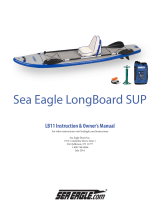
The Basics: Stand Up Paddling
For tips and videos visit us at Youtube.com/SeaEagleBoats.
If you are not an experienced stand up paddler, we suggest that you start in calm shallow flat water and practice for an
hour or two before paddling out into deeper water. We also recommend that you do so when the water temperature is
comfortable for swimming. Do not be discouraged if you fall in a few times.
Standup Paddling is much like water skiing, it takes some practice and experience to be proficient. Give it some time and
don’t give up. This is a wonderful experience and pastime once you get used to it.
When getting on the board, have your SUP paddle already in your hand and make sure you are in deep enough water (1’
or more) so the large skeg is not scraping the bottom - you want it to be free to do its thing.
Center your foot on the board and stand up bringing your other foot up onto to the board one or two feet in front of your
other foot. Once you are standing, move your feet (one at a time) further to sides, one a little bit in front of the other.
Use your SUP paddle for balance, switching it side to side as needed. It is a good idea to get used to moving your feet for-
ward and backward, always using your SUP paddle to counter balance your weight. As soon as you are comfortable, start
paddling forward keeping most of your weight in the center of the board.
As you paddle forward, switching your paddle from one side to another, experiment paddling with longer and shorter
strokes. Please note, you can paddle two strokes or more on one side if you have sufficient momentum. As the board
turns to the other side, switch your paddle to correct.
The Basics: Sit Down Paddling
Before starting make sure that you have installed your deluxe inflatable seat on the NeedleNose and it is properly at-
tached (as directed in this manual). The sit down position is ideal for using our optional foot rest as you’ll paddle better
and faster if you have a secure foot brace to push your feet against. For sit down paddling use the AB-30 kayak paddle.
Flat Open Waters, Waves & Ocean Surf:
Once you become proficient in paddling shallow water, you can expandyour practice to deeper waters. As time goes by,
you can try paddling on rougher water days, getting used to the drop and pitch of larger lake or bay waves. Once you feel
comfortable with paddling on flat water in different wave conditions, you can consider paddling in ocean surf.
Again, we think you should go out on calm day to start. Try to pick a day with small waves that you can practice in. As you
become used to smaller ocean waves, then try larger waves. Here, some knowledge of surfing and swimming in the
ocean is very important.
These instructions are not sufficient to going into detailed surfing lessons. We suggest you go online and read up on surf-
ing, if you do not have ocean surfing experience. Please also note, there are many good surfing courses offered locally
throughout the country that you might consider.
Bay, Lake & Ocean Paddling
Your Sea Eagle SUP can be used on lakes, bays and oceans. One thing you might notice if you are accustomed to hard
hull kayaks or canoes is the natural yaw (side to side motion). The two small skegs and the large center skeg prevent
most of the yaw. The way you paddle can prevent most of the rest of the yaw.
Big Paddling Tip: When you begin to paddle, paddle slowly at first, building speed with each stroke to control the natural
yaw further and allow you to paddle straighter and faster.
Sit Down Ocean Surfing
The Sea Eagle Long Board is a great pleasure on the ocean. Those not familiar with the ocean should take appropriate
care, and always paddle within range of a lifeguard station.
2
OPERATING YOUR SEA EAGLE




















